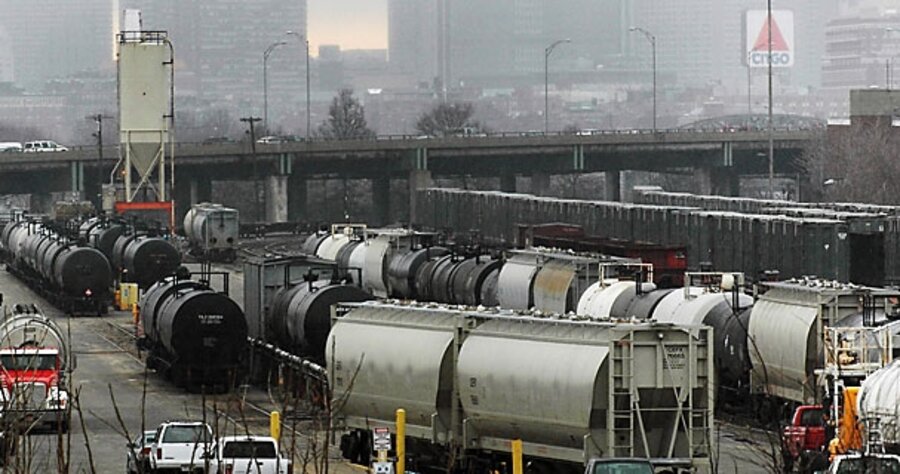Rule OK’s chemical tankers through cities
Loading...
| New York
The Bush administration has finalized a controversial regulation that will allow railroads to continue to ship dangerous chemicals through major cities.
That has infuriated some city officials, security experts, and environmentalists because it preempts all local efforts to control if, when, and how those railroad tank cars move through their communities.
Federal security officials have long considered railroad tankers full of such chemicals as chlorine or anhydrous ammonia to be potential weapons of mass destruction. If attacked by a terrorist or disturbed individual in the middle of a city they could cause thousands of deaths.
The finalization of the rail routing rule is one of the latest “midnight rule changes” pushed through by the outgoing administration in an effort imprint its preferences on the federal bureaucracy.
It’s a common political maneuver when the White House changes hands. But it’s controversial, and although many last-minute rule changes are eventually reversed, it takes time.
In this instance, the regulation leaves the decision of which route to take with deadly chemicals primarily in the hands of the railroads. Critics contend that this leaves too many communities vulnerable to a serious security threat and that state, local, and federal officials should have more input to ensure the chemicals are transported along the shortest, safest, and most secure routes.
States want more say in train routing
The National Conference of State Legislatures has called on the incoming Obama administration to rescind the regulation quickly.
“These are going to be seemingly unilateral routing decisions made by the railroads without the ability of state and local policymakers or other knowledgeable experts to have any input whatsoever as to how these trains are routed through our jurisdictions,” says Susan Parnas Frederick, federal affairs counsel of the National Conference of State Legislatures.
The Bush administration and the railroads defend the rule, saying it will require the railroads to ensure such materials are shipped on the “safest and most secure” routes. The railroads must assess 27 different criteria before determining which route is best, including proximity to densely populated and environmentally sensitive areas. Officials at the Federal Railroad Administration also say that there is a specific mechanism in the new rule that allows local officials to have input about their own communities.
“There is an opportunity for local communities to provide their views on potential routings,” says Warren Flatau, a spokesman for the Federal Railroad Administration. “And if they believe the railroad’s decision did not take their concerns into account, they could certainly come to us and ask us to audit the railroad’s decision.”
Critics note that there will be no way for local or state officials to know for sure if their concerns are being taken into account. That’s because there is no requirement that state and local officials be notified of the route once it is finalized or be informed of the decisionmaking process that determined it. Such decisions are considered “security sensitive” by the federal government and so will remain secret from state and local officials.
“All of the documentation will be secret, and the results will be secret,” says Fred Millar, a consultant to the environmental group Friends of the Earth. “It’s conceivable that not a single elected official in this country will be told the results of this, because the only people that need to be told are people with a ‘need to know’. Challenging any decision is just going to be a can of worms.”
Railroads pledge public safety
But railroad officials say such concerns are overblown, and they insist they will ask for local input in making their decision, as they always have.
“The railroads are already working with local governments and [hazardous material] people and the chemical companies and will continue to do so,” says Tom White, a spokesman for the Association of American Railroads in Washington, an industry trade group.
He also insists the regulation is designed in a way that best protects the public, because the people who are best equipped to understand the security of hazmat transport are the ones making the decision.
“It is the railroads who understand best what is required to transport hazardous materials, and it is the railroads who understand best the routes and their technical limitations,” says Mr. White. “If you started giving local authorities the ability to mandate rerouting you could end up with a situation where it would be impossible to move the stuff at all. Why? Because every local community would then do that.”
The American Chemistry Council in Arlington, Va., which represents chemical companies, asserts that the transport of hazardous materials should be in federal, not state and local, hands. “Our primary concern has always been that there be a federal approach to this,” says council spokesman Scott Jensen. “You really need to take a comprehensive approach to the routing of chemicals because of the very nature of the rail system.”
But state and local officials are concerned the railroads may end up favoring routes that are the most financially expedient rather than the most secure. “Without the input of state and local officials it’s hard to know what will motivate the decisions in routing,” says Ms. Frederick.





